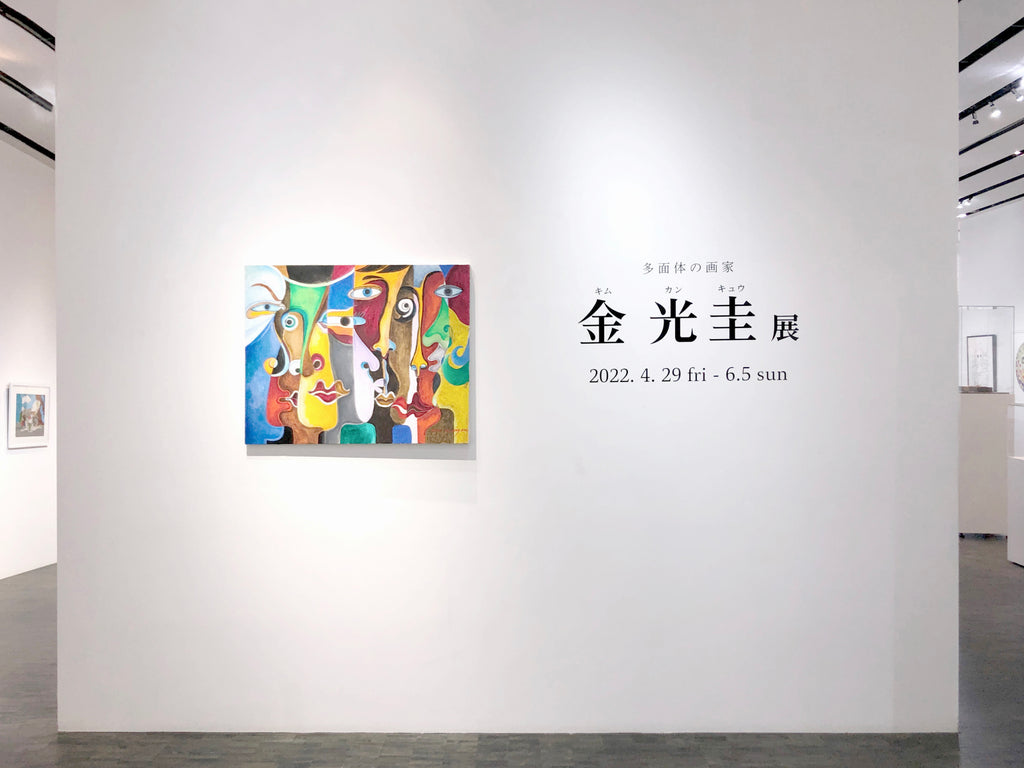

Multifaceted Artist: The exhibition of Kim Kwaing Kyu
Karuizawa Gallery 2, 3
April 29 - June 5, 2022
Kim Kwaing Kyu was born in 1959 in South Korea and raised there. Following study at art school in Korea, he worked for six years at the French jewelry design group Christian Bernard in Paris where he established himself as a jewelry designer. Since 1993, he has been based in Japan, developing a highly successful career as a jewelry designer. Though his creations reveal the exquisite artistry and sensibility of a master craftsman, Kim claims that his main focus is actually painting. His recent robust painting output gives credence to this.
The relatively recent works on display in this exhibition demonstrate tremendous variation in subject matter, motifs, and style. The viewer’s attention is immediately drawn to Kim’s series on the motif of faces such as Face Curtain, Block Man, World Travel, and Parallel World. Although the depictions are of faces, they are far from individual unique faces in the sense of a portrait. The Block Man series faces are geometrically standardized rather than realistically human and carry no indication of gender. They are, however, not in the realm of automatons. Are these faces, positioned frontally or in profile, an expression of modern society’s uniform and anonymous masses? Since ancient times, portraits of kings and powerful figures have mostly emphasized immobile frontality in order to impart on the viewer a sense of unshakeable presence, power, and dignity. The Block Man series also emphasizes frontality, but in a different sense. The wide-open eyes stare at us while seeming simultaneously to be peering into their own inner selves.
For Face Curtain, nose, mouth, and other features are basically deformed while eyes, sometimes large and prominent, stare or seem to be absorbed in thought. They may appear as surrealistic and strange or iconic of the anxiety and sadness of present times. While Block Man may be viewed as hard-edged, linear, masculine, or lifeless, Face Curtain may be seen as soft-edged, curvilinear, feminine, and alive. In both cases, canvases filled almost entirely by faces and heads, whether in profile or facing forward, may symbolically signify the priority in our times of the mass over the individual. The color schemes of the pieces, organized in monotones of red, blue, and black, suggest interesting possibilities for color psychology study.
Parallel World is also associated with Kim’s face motif series but here the even more numerous crowds radiate an enormous but undirected energy. Though there are some humorous nuances, the world of the crowd is one loneliness, alienation, and anxiety. Kim’s Parallel World 4 is compositionally reminiscent of Belgian artist James Ensor’s Christ’s Entry into Brussels (1889), a masterpiece of modern painting. Kim’s long-haired man, gazing at us alone in the crowd, seems to be a descendant of Ensor’s Christ, lost and lonely in a vast crowd of the 21st century.
It is surprising that Kim produced abstract works prior to, after, or even in parallel with these more or less figurative works. Birth, Fusion, Separation, Life Cycle and others appear to be extensions or variations of the Face series that incorporate an eye motif, but these are independent with their own motifs.
The Birth series, in contrast to the coolness of the Block Man series, features the energy of an almost Fauvist euphoria of primary colors to depict a 21st century version of the myth of the creation of the universe or perhaps the Genesis creation myth. In terms of art history, the series can be related to and considered a manifestation of Kandinsky’s ‘hot abstraction’ and the passionate Dionysian spirit of early 20th century abstract art, opposed to the classical Apollonian values of harmony, balance and tranquility.
The Life Cycle series works together with the dramatic Birth series to emphasize abstraction. Like the Block Man series, the monochrome Life Cycle works are based on particular colors and contrast with the Birth series. Though Kim’s titles generally do not offer an explanation of the works, Life Cycle is a case where it does. The infinitely intertwining curves that reach beyond the frame of the painting, leading to the outside world, could be identified as ‘cycle of life’ in seemingly in a transitional stage from chaos (disorder) to cosmos (ordered space). Though each of Kim’s series forms its own independent world (“Kim’s world”), Kim relates that he does not at all consider subject matter when he creates works but rather simply waits for images to spontaneously emerge. This recalls the Surrealist idea of automatism, and many noteworthy works.
Many ‘faces’ emerge from Kim’s World this time, including visions of the fantastic and the surrealist, the vague anxiety of modern alienation, and the Informel, Constructivist, and Geometric Abstractionist styles. Rather than asking which is the ‘real Kim, we should say that they are all part of the multifaceted painter Kim Kwaing Kyu. I look forward to INNER SCAPE development reflected in Kim’s ubiquitous mind’s eye.
Nobuyuki Senzoku
Director, Hiroshima Prefectural Art Museum






Karuizawa Gallery
1F / KARUIZAWA NEW ART MUSEUM, 1151-5 Karuizawa, Karuizawa-machi, Kitasaku-gun, Nagano, 389-0102, Japan
Tel: +81 (0)267 46 8691
Fax: +81 (0)267 46 8692
Opening Hours: 10:00 - 17:00
Closed: Monday